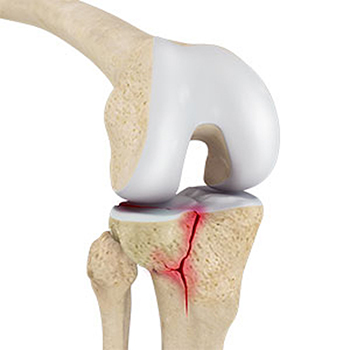Types of Tibial Plateau Fracture
Tibial plateau fractures can be classified based on various factors, including the specific pattern of the fracture, the amount of displacement, and the involvement of the joint surface.
Lateral Tibial Plateau Split Fracture: This type involves a fracture in the outer (lateral) portion of the tibial plateau. It is often associated with high-energy trauma and may result in instability of the knee joint.
Medial Tibial Plateau Split Fracture: Similar to a lateral tibial plateau fracture, a medial tibial plateau fracture involves a break in the inner (medial) portion of the tibial plateau. It can also lead to instability and may be associated with other injuries.
Bicondylar Fracture: Bicondylar fractures involve both the lateral and medial aspects of the tibial plateau. These fractures are often more complex and may require careful surgical management to restore stability to the knee joint.
The Schatzker classification is a system that categorizes tibial plateau fractures into six types based on the pattern of the fracture lines and the involvement of the joint surface. It helps guide treatment decisions. The types range from less severe (Type I) to more complex (Type VI).
- Schatzker I: Lateral plateau split fracture
- Schatzker II: Lateral plateau split-depressed fracture
- Schatzker III: Lateral plateau pure depression fracture
- Schatzker IV: Medial plateau fracture
- Schatzker V: Bicondylar plateau fracture
- Schatzker VI: Metaphyseal-diaphyseal dissociation

- Split Fracture vs. Depression Fracture: Tibial plateau fractures can also be classified as split fractures, where the bone splits into two separate parts, or depression fractures, where a portion of the bone is depressed into the joint space.
- Impaction Fracture: In an impaction fracture, the force applied to the knee causes compression of the bone, leading to a depression in the tibial plateau. This type may not involve a complete break but can still affect joint function.
Non-Displaced vs. Displaced Fractures: Fractures can be categorized as non-displaced (minimal or no shift in bone alignment) or displaced (significant shift or separation of bone fragments). Displacement may impact treatment decisions.
A tibial avulsion fracture occurs when a small fragment of bone is pulled away from the tibia due to the force of a muscle or ligament pulling on it. This type of fracture typically involves an avulsion, where the bone fragment is detached at the site where a tendon or ligament attaches. Avulsion fractures can occur in various locations on the tibia, and the specific location depends on the muscle or ligament involved. The most common tibial avulsion fracture involves the ACL. Tibial avulsion fractures can happen during sudden and forceful contractions of the muscles or due to a traumatic event.
There are several types of tibial plateau fractures, classified based on the severity of the break, bone displacement, and involvement of the joint surface. Non-displaced fractures occur when the bone remains properly aligned and may heal without surgery. Depressed fractures involve a portion of the bone being pushed downward, which can affect joint movement. Split fractures cause the bone to break into separate pieces, while comminuted fractures result in multiple bone fragments. In severe cases, open fractures occur when the bone breaks through the skin, requiring immediate medical attention. Dr. Jorge Chahla specializes in assessing and treating all types of tibial plateau fractures, tailoring treatment based on the severity and individual needs of the patient. If you have suffered a tibial plateau fracture, contact Dr. Chahla’s office in Chicago, Naperville, or Oak Brook for a detailed evaluation and treatment plan.
At a Glance
Dr. Jorge Chahla
- Triple fellowship-trained sports medicine surgeon
- Performs over 700 surgeries per year
- Associate professor of orthopedic surgery at Rush University
- Learn more

